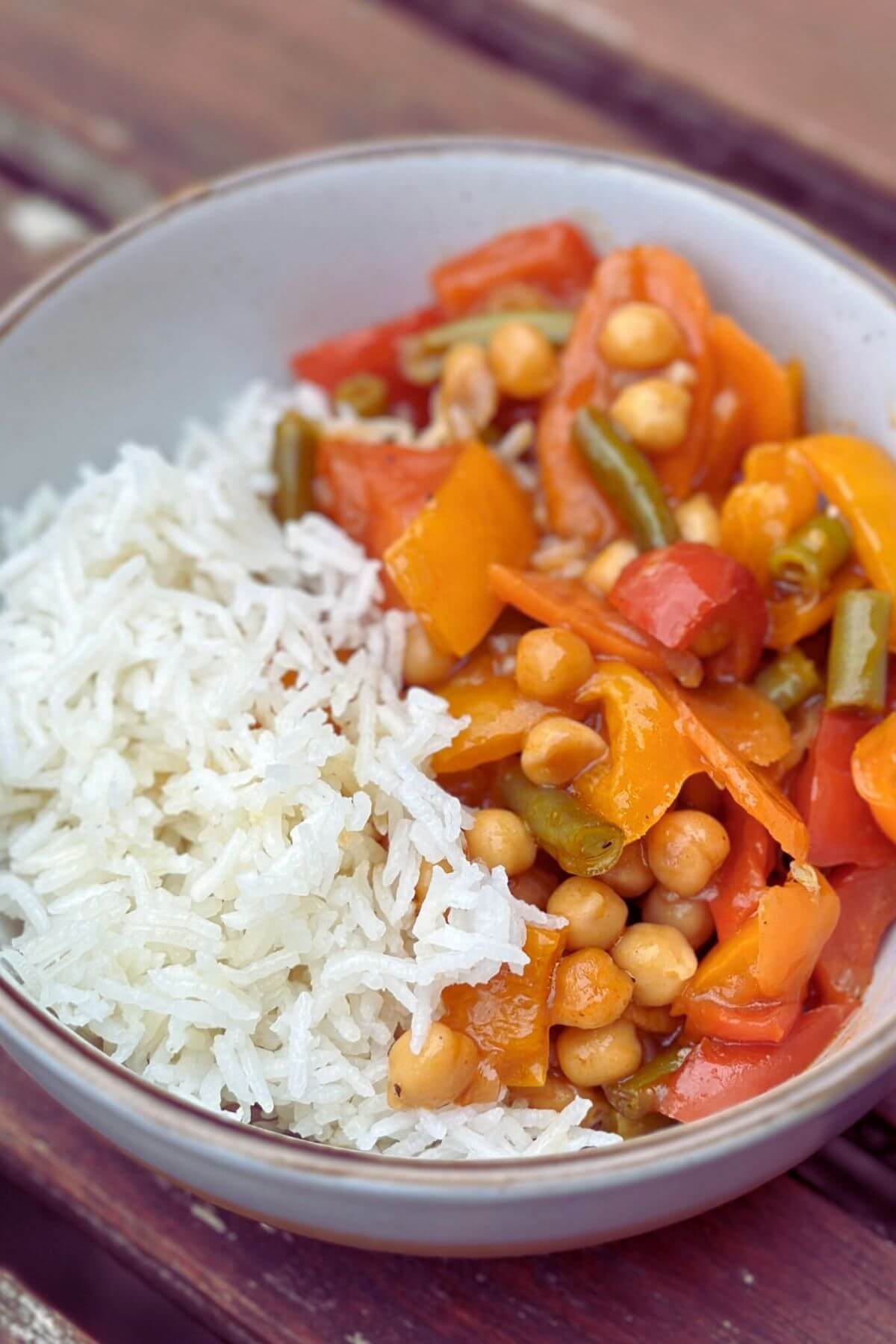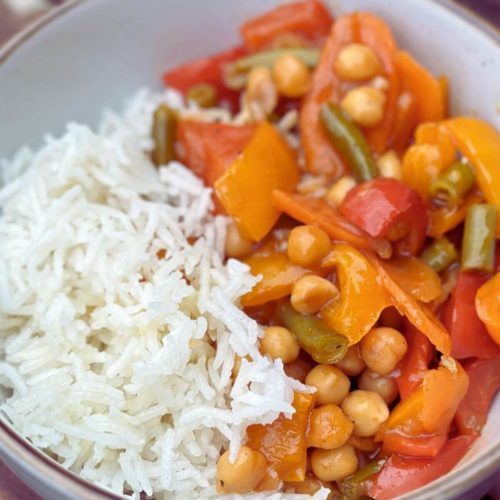How to make Sweet & Sour Vegetable Stir Fry
Learn how to make an easy Sweet and Sour Vegetable Stir Fry! Perfect for a quick, healthy meal with vibrant veggies and a tangy sauce. Ideal for weeknight dinners!

I always find myself using the ingredients I have in my cupboard, especially before heading out for food shopping. I aim to utilize all the food I have to minimize food waste. It’s amazing how many interesting recipes come out of this process.
I especially enjoy quick and easy recipes that can be paired differently each time. This chicken stew pairs wonderfully with steamed rice, Turkish bulgur, pasta, mashed or baked potatoes, a slice of freshly baked bread, or on its own with a piece of homemade tortilla.
This veggie dish is ideal for a fast meal on busy days. Whether served as a main course or a snack, it’s bound to leave everyone wanting more. You should also try our Lemon Chicken, Easy 15-minute Udon Noodles, Turkey Mince Noodles, or Gnocchi made easy with Pesto and Zucchini for a quick delicious lunch or dinner.
OUR LATEST VIDEOS
Looking for more? Check out these Dinner Recipes!
I love quick, restaurant-quality dishes that taste amazing and are easy to make. In just 30 minutes, I can make a delicious meal for my family with ingredients I control. It’s also great as a low-carb keto main. Sharing homemade meals creates special memories that last.
Watch Us Make The Recipe
Why you’ll love this recipe
This recipe for Sweet and Sour Vegetable Stir Fry is a hit because it’s quick, easy, and uses basic ingredients. The vibrant veggies in a tangy sauce make it a family favorite.
It’s a simple dish perfect for busy nights, and you can pair it with any side dish you like. Since it’s homemade, you know exactly what goes into it, making it a healthier choice. Kids love it too, and it’s low in calories, so it’s a win-win for everyone at the table.
A make-ahead-friendly recipe, you can prepare in advance, store, and reheat when needed, making it a great option for meal prepping.
Expert Tips
Prep Ingredients Ahead: Have all your vegetables chopped and sauce mixed before you start cooking. Stir fry cooking is fast, so being prepared ensures everything cooks evenly and perfectly.
High Heat Cooking: Use high heat for quick cooking to retain the vegetables’ vibrant color and crisp texture. A hot wok or large skillet best achieves that classic stir fry finish.
Balance the Sauce: Taste and adjust the sweet and sour sauce to your preference before adding it to the vegetables. You can tweak the sweetness with more sugar or the tanginess with more vinegar or citrus juice.
Ingredients
Olive Oil: Helps cook veggies, use a non-stick pan.
Onion: Adds taste, chop finely for even cooking.
Red and Orange Bell Peppers: Adds crunch, and cut into small pieces.
Carrots: Adds sweetness, slice thinly for quicker cooking.
Cooked Chickpeas: Adds protein, use canned for convenience.
Green Beans: Adds freshness, trim ends before slicing.
Garlic: Adds taste, finely chop or crush for best results.
Salt and Pepper: Season to taste, start with a pinch.
Paprika: Adds smokiness, use sparingly for a subtle taste.
Chinese Sweet & Sour Concentrate: Makes the sauce, and mix with hot water as directed.

Substitutions
Olive Oil: Can be replaced with any cooking oil like vegetable oil or canola oil.
Onion: Shallots or leeks can be used as alternatives for a similar taste.
Red and Orange Bell Peppers: Yellow or green bell peppers, or even other vegetables like zucchini or eggplant, can be substituted.
Carrots: Other root vegetables like parsnips or turnips can be used, or you can try thinly sliced sweet potatoes for a sweeter twist.
Cooked Chickpeas: Cannellini beans, black beans, or lentils can be used as substitutes for chickpeas.
Green Beans: Snow peas or snap peas can provide a similar crisp texture.
Garlic: Garlic powder or garlic paste can be used as substitutes for fresh garlic cloves.
Salt and Pepper: These can be adjusted to taste, and any other preferred seasoning can be used as well.
Paprika: Smoked paprika, chili powder, or cayenne pepper can provide a similar smoky flavor.
Chinese Sweet & Sour Concentrate: If unavailable, you can make a homemade sweet and sour sauce using ingredients like ketchup, vinegar, sugar, and soy sauce.
How to serve
Sweet and sour vegetable stir fry is a versatile dish that pairs well with a variety of serving options. Here are some popular choices:
Rice: Serve the sweet and sour vegetable stir fry over steamed white rice or brown rice.
Noodles: Serve the stir fry with cooked noodles such as rice noodles, udon noodles, or chow mein noodles. Toss the noodles with the vegetables and sauce for a delicious combination.
Quinoa: For a healthier alternative to rice or noodles, serve the stir fry with cooked quinoa. Quinoa adds a nutty taste and a satisfying texture to the dish.
Lettuce Wraps: For a lighter option, serve the sweet and sour vegetables in lettuce cups. Simply spoon the stir fry into large lettuce leaves, such as iceberg or butter lettuce, and roll them up like wraps.
Tofu or Tempeh: Add a protein component to your meal by including tofu or tempeh in the stir fry. You can marinate and stir-fry them along with the vegetables or serve them on the side.
Garnishes: Sprinkle some chopped green onions, cilantro, or sesame seeds over the sweet and sour vegetable stir fry.
Side dishes: Consider serving the stir fry with additional side dishes like steamed or stir-fried bok choy, broccoli, or snap peas.
My Favorite Products
Shop my Favorite Items to personalize your home
Looking for more? Check out +20 Best Mains Easy Recipes!
Did you give this Sweet and Sour Vegetable Stir Fry recipe a try? Please share your experience by rating it ⭐️⭐️⭐️⭐️⭐️ and dropping a comment below. Your feedback is greatly appreciated and fuels my passion for creating recipes!
Follow me on Instagram – Pinterest or Facebook and tag your creations
